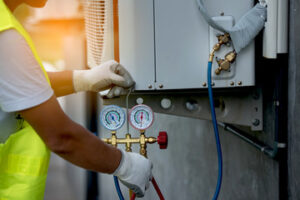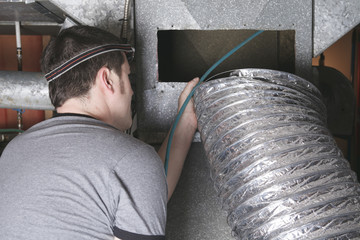Current HVAC Trends
The HVAC industry is seeing a lot of growth. From smarter thermostats to geothermal heating, it’s all about sustainable solutions for homeowners.
Automation of call booking, estimating, and payment collection is also rising. That gives office staff and field techs more time to focus on customer service and company culture. Read https://comfortprosheatandair.com/ to learn more.

As 3D printing continues to gain traction, HVAC companies are finding new ways to integrate this technology into their products. The most recent development is a cooling system that uses 3D-printed heat exchangers. These parts are designed to be more efficient and lightweight than current models, which can reduce energy costs by up to 20%.
The heat exchanger is an integral component of any air conditioning system, as it is responsible for the liquefaction of refrigerant gas in the condenser unit. The liquefaction process consumes most of an air conditioner’s energy, so the more efficient the part, the more efficient the entire team will be. The heat exchangers in the new system are made of alumina ceramic, which has superior thermal conductivity to traditional stainless steel heat exchangers. The new design is also lighter and more durable than the conventional versions.
Cooling systems that use the new heat exchangers will also be able to run on alternative fuel sources such as biofuels, which can help reduce dependence on fossil fuels and lower carbon emissions. The new units will be available for commercial sale within four years.
While the new heat exchangers are a significant advancement, there is still much more work to be done in the HVAC industry regarding creating more environmentally conscious cooling systems. Air conditioners use a massive amount of energy, and researchers have been working on ways to cut that consumption for decades. However, innovation in this area could be faster. One researcher says it is “like nuclear fusion, always 20 years in the future.”
Despite the challenges of developing low-energy cooling solutions, there are signs that this trend is picking up speed. A recent study analyzing the energy usage of air conditioners found that there has been an increase in efficiency over the past decade. That is largely due to advances in heat exchangers, which have reduced the energy needed to liquefy and cool the refrigerant. Other improvements to air conditioning systems include inverters, which can eliminate wasted fan motor speeds by optimizing them to their specific needs. That reduces the demand for electric power plants and can help reduce the risk of brownouts.
HVAC industry trends are reflecting a focus on sustainability and smart technology. Many new HVAC systems are energy-efficient and eco-friendly, with many utilizing solar power or geothermal heating and cooling. These systems also qualify homeowners for tax credits and save on energy costs. This trend is expected to grow as consumers demand greener home options.
Another trend that is affecting the HVAC industry is personalized customer service. Consumers want businesses to understand their needs and offer solutions that are tailored to them. That requires a commitment to collecting and analyzing data about individual customers. By doing so, businesses can provide a better experience for their clients and build brand loyalty.
As a result of these changes, the demand for HVAC contractors is growing. That is because younger generations (such as millennials) are entering the workforce and need HVAC services for their homes. HVAC businesses can attract this population and grow their revenue streams by offering these services.
Many HVAC companies use online project management tools to streamline task assignments and ensure that all team members have the necessary resources. These platforms allow technicians to identify equipment, components, and locations within a job site easily. That can help to reduce overall project costs and improve productivity.
In addition, some HVAC contractors are adopting digital payment methods to speed up the process of completing jobs and receiving payments. That can be done by implementing a mobile application that allows workers to receive payments immediately after completing invoicing. It eliminates the need to send paper invoices to clients and wait for them to be paid.
Lastly, some HVAC companies are creating HVAC products that are more compact and easy to use. That can be achieved by making them user-friendly and including features that cater to the individual needs of each consumer. For example, a smart thermostat may be programmed to adjust the temperature automatically based on the homeowner’s schedule and preferences.
The future of the HVAC industry is bright, but some challenges still need to be addressed. One of the most pressing issues is the need for more qualified technicians. The industry should focus on providing more training opportunities for young people to address this. That will help to increase the number of skilled HVAC professionals and make it easier for businesses to find quality employees.
HVAC systems that can self-diagnose and self-manage are a growing trend in the industry. These systems can gather data, identify problems, and send notifications to maintenance staff to improve system efficiency and reliability. That can reduce costs and maintenance expenses by improving system performance and speeding up repair times. Additionally, these systems can help to save energy by identifying areas of high energy use and minimizing energy consumption.
The rise of green initiatives has increased the demand for HVAC products that are eco-friendly and sustainable. That is good news for the HVAC industry as customers are willing to pay more for environmentally friendly solutions that can offer greater energy efficiency and savings.
Some smart HVAC systems can monitor a building’s occupancy and weather conditions to optimize airflow and temperature for maximum energy efficiency. That helps businesses save on utility bills and improve occupant comfort by keeping indoor temperatures consistent regardless of outside weather. Some smart HVAC systems can also monitor and control indoor air quality by adjusting ventilation levels to ensure a healthy working environment.
Increasing energy costs and rising power shortages drive the adoption of smart technology, including smart HVAC systems, in commercial buildings. Integrated sensors can detect a building’s temperature, humidity, airflow, and CO2 levels, and intelligent algorithms can adjust the amount of air pumped into each space depending on occupancy and needs. That can significantly cut energy costs, making it an attractive option for commercial property owners.
In addition, some smart HVAC systems can track building performance over time to identify usage trends and identify problems before they become major issues. That is made possible by cloud-based systems that gather and analyze data and by software that detects problems and suggests solutions to resolve them quickly and efficiently.
Some smart HVAC systems can connect to share data and provide more efficient control of the whole building, including its lighting and window shades. They can also be controlled remotely from a single dashboard to increase convenience and reduce energy bills. The smart HVAC industry is transforming how buildings are run and managed, and these advances are expected to create more connected and energy-efficient buildings in the future.
HVAC systems account for about half of a home’s energy consumption. Homeowners are increasingly seeking environmentally friendly equipment to reduce their energy costs and carbon footprint. That leads to increased demand for smart technology, including smart thermostats and solar HVAC systems. It also drives interest in more sustainable options, such as geothermal heating and air-source heat pumps.
As consumers seek out cost-efficient products, they also demand higher quality and efficiency from HVAC equipment. That leads to increased sales of smart systems that feature variable speed compressors, which can save up to 30% more energy than conventional systems. These systems can also deliver better indoor comfort without causing sudden bursts of air or wide temperature swings.
Additionally, more homeowners are looking for products that offer a higher level of personalization. Many people working remotely or with family members who work from home need a system that can adapt to their schedules and accommodate different needs. That leads to the growth of zoning, which allows HVAC system controls to adjust to a specific area of the house or office.
While the HVAC industry continues to grow, supply chain shortages have challenged many contractors. As such, they have been forced to find creative ways to boost profits while reducing expenses. That includes implementing new software tools and systems to streamline their operations and improve customer service. These solutions help them track leads, communicate with clients, and provide better technical support.
Lastly, HVAC companies are increasing productivity and efficiency by using technology to automate some of their processes. That helps them avoid costly mistakes, reduce personnel fatigue, and ensure that projects are completed on time. Investing in these technologies can significantly impact your business’s bottom line and give you a competitive advantage.
By keeping an eye on the latest HVAC trends, you can be sure that your company is growing and providing customers with the best services. With a focus on effective marketing, strong customer service, and profit pricing, you can ensure your business stays at the top of its field.

